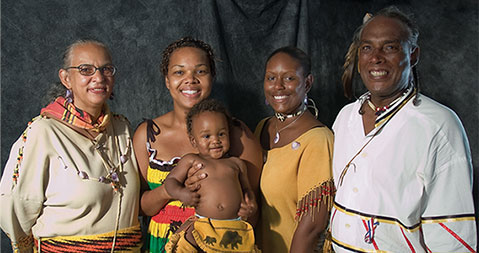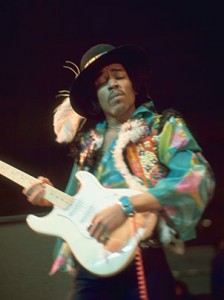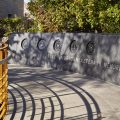IndiVisible: These people belong to each other
Within the fabric of American identity is woven a story that has long been invisible—the lives and experiences of people who share African American and Native American ancestry.
“IndiVisible: African–Native American Lives in the Americas,” a 20-panel exhibition that outlines the seldom-viewed history and complex lives of people of dual ancestry, opens Feb. 9 at the National Museum of the American Indian’s George Gustav Heye Center in New York.

Foxx family (Mashpee), 2008 From left, Anne, Monet, Majai (baby), Aisha and Maurice Foxx. (Photograph by Kevin Cartwright)
Since pre-colonial times, Native and African American peoples have built strong communities through intermarriage, unified efforts to preserve their land and taking part in creative resistance in the face of legal and economic constraints. Over time, these communities developed constructive survival strategies, and several regained economic sustainability through gaming in the 1980s. Prejudice, laws, and twists of history have often divided them from other Americans, yet African-Native American people were united in the struggle against slavery and dispossession, and then for self-determination and freedom. “IndiVisible” not only addresses the discriminatory laws that have been forced on Native, African American and mixed-heritage peoples but also the daily cultural practices that define the African–Native American experience through food, language, writing, music, dance and the visual arts.

“When the power of love overcomes the love of power, the world will know peace.” The rock-and-roll innovator Jimi Hendrix often spoke proudly of his Cherokee grandmother. He was one of many African Americans who cite family traditions in claiming Native ancestry. (Image courtesy Experience Music Project and Science Fiction Museum and Hall of Fame)
The exhibition was curated by leading scholars, educators and community leaders, including Gabrielle Tayac (Piscataway), Robert Keith Collins (African-Choctaw descent), Angela Gonzales (Hopi), Judy Kertèsz, Penny Gamble-Williams (Chappaquiddick Wampanoag) and Thunder Williams (Afro-Carib).
The accompanying exhibition book, IndiVisible: African–Native American Lives in the Americas, edited by Tayac, features 27 essays from authors across the hemisphere sharing first-person accounts of struggle, adaptation and survival and examines such diverse subjects as contemporary art, the Cherokee Freedmen issue and the evolution of jazz and blues. The richly illustrated 256-page book is available in Smithsonian museum stores and through the Bookshop section of the museum’s website.
Tayac and Heriberto Dixon (Tutelo) will discuss the history of mixed-heritage Native people at the museum on Thursday, Feb. 9, at 6 p.m. in the Diker Pavilion. The event is free and a book signing will follow the discussion.
Posted: 11 January 2012







